
cbse notes, cbse syllabus, cbse books, cbse class 11 biology notes, cbse sample papers, cbse biology notes, cbse question papers, cbse study material, cbse class 11 physics notes, cbse notes for class 11, cbse notes for class 10, cbse biology, biology notes for class 11 cbse, cbse class 12 chemistry notes, cbse 11, cbse 11 biology notes, cbse notes for class 11 biology, cbse class 12 biology notes, cbse class 11 biology, cbse biology notes for class 11… , animal kingdom 11 notes, class 11 biology notes, animal kingdom class 11, animal kingdom class 11 notes, class 11 animal kingdom, note biology, biology notes, animal kingdom, class 11 cbiology chapter 4 notes, 11th standard biology notes, 11th std biology notes, class 11 biology notes chapter 4, animal kingdom chapter class 11
| 1 | Symmetry | : | Distribution of body parts around a | |||||||
| 2 | hypothetical axis. | : | Ostia : Minute pores on body of sponge. | |||||||
| 3 | Osculum | : | Large outlet in body of sponge. | |||||||
| 4 | Hermaphrodite | : | Bisexual. | |||||||
| 5 | Polyp | : | Sessile cylindrical form of coelenterate (Asexual). | |||||||
| 6 | Medusa | : | Umbrella shaped free swimming sexual stage of coelenterate. | |||||||
| 7 | Acoelomate | : | No coelom. | |||||||
| 8 | Pseudocoelom | : | With false coelom (cavity not underlined by mesoderm). | |||||||
| 9 | Dioecious | : | Unisexual. | |||||||
| 10 | Operculum | : | Cover over gills in fish | |||||||
| 11 | Notochord | : | Dorsal rod like bone | |||||||
| 12 | Homoiotherms | : | Warm blooded. | |||||||
| 13 | Bioluminescence | : | Emit light. | |||||||
-Levels of organisation |
||||||||||
| i) | Cellular level- loose cell aggregates, small division of labour eg. Sponges | |||||||||
| ii) | Tissues grouped into organs eg. | |||||||||
| Coelenterate. | ||||||||||
| iii) | Organ level-Tissues grouped into organs eg. Higher animals. | |||||||||
Circulatory system |
||||||||||
| a) | Open type- No blood vessels, blood flows in sinuses. | |||||||||
| b) | Close type- Blood flows in closed vessels. | |||||||||
Symmetry |
 |
|||||||||
| - | Asymmetrical – No symmetry eg. Sponges. | |||||||||
| - | 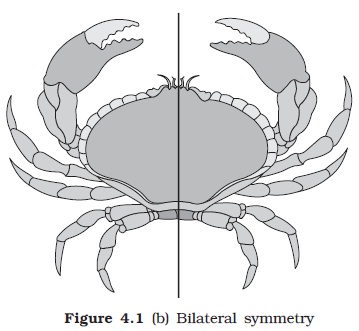 |
|||||||||
| - | Radial Symmetry – Any plane passing through central axis divides body in two equal halves. | |||||||||
| - | Bilateral Symmetry – Body can be divided into two equal halves through one plane only. | |||||||||
Diploblastic and Triploblastic organisation – |
||||||||||
| - | Two embryonic layers – Ectoderm and Endoderm – Diploblastic. | |||||||||
| - | Three embryonic layers- Ectoderm, Mesoderm and endoderm- Triploblastic. | |||||||||
Coelom – |
||||||||||
| - | Body cavity lined by mesoderm- True Coelom. | |||||||||
| - | Body cavity not lined by mesoderm Pseudo Coelom. | |||||||||
| - | No body cavity – Acoelomate. |
|||||||||
Segmentation – |
||||||||||
| - | True segments- Metameres (Body divided internally and externally). | |||||||||
Notochord – |
||||||||||
| - | With notochord – Chordates. | |||||||||
| - | Without notochord – Non-Chordates. | |||||||||
Classification of Animals – |
||||||||||
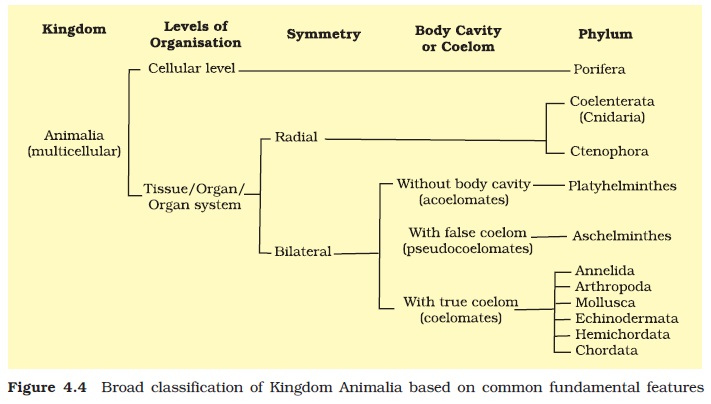
Phylum Porifera – |
||||
| - | Marine. | |||
| - | Multicellular, cellular grade body. | |||
| - | Asymmetrical. | |||
| - | Water canal system for food, respiration and excretion. | |||
| - | Body wall with many pores – Ostia. | |||
| - | Diploblastic. | |||
| - | Water enters through Ostia and goes out through Osculum. | |||
| - | Skeleton of spicules or spongin fibres. | |||
| - | Hermaphrodite. | |||
| - | Reproduction asexual by fragmentation and sexual by gametes. | |||
| - | Fertilisation is internal, development indirect. | |||
| - | eg. Sycon, Spongilla, Euspongiaetc. | |||
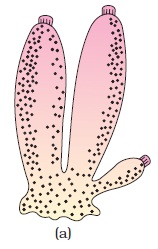 |
||||
Phylum Coelenterata (Cnidaria) – |
||||
| - | Aquatic (marine), Sessile or free living. | |||
| - | Presence of Cnidoblasts or Cnidocytes – Stinging cells. | |||
| - | Cnidoblasts are for defence, anchorage or predation. | |||
| - | Tissue level body organisation. | |||
| - | Diploblastic. | |||
| - | Central gastro vascular cavity, single opening mouth. | |||
| - | Two body forms – Polyp (Asexual), Medusa (Sexual) stage. | |||
| - | eg Hydra, Physalia, Obelia, Aurelia etc. |
|||
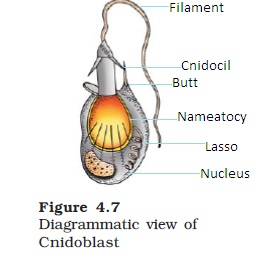 |
||||
Phylum Ctenophora (sea walnuts or comb jellies) – |
||||
| - | Marine, radial symmetry, Diploblastic, tissue grade. | |||
| - | Eight external rows of Comb Plates. | |||
| - | Bioluminescence. | |||
| - | eg. Ctenoplana, Pleurobrachia etc. | |||
| - | Reproduction sexual. | |||
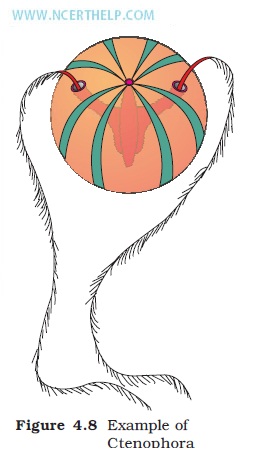 |
||||
Phylum Platehelminthes (Flat worms) – |
||||
| - | Body dorsiventrally flattened. | |||
| - | Endoparasite. | |||
| - | Triploblastic, bilateral symmetry. | |||
| - | Acoelomate | |||
| - | -Flame cells- for excretion & osmoregulation. |
|||
| - | -Flame cells- for excretion & osmoregulation. |
|||
| - | Hermaphrodite | |||
| - | Reproduction – Sexual - Fertilisation internal. | |||
| - | Organ level organisation. | |||
| - | eg. Taeniasolium(Tape worm), Fasciola hepatica (liver fluke). | |||
| Phylum Aschelminthes (Round Worm) – | ||||
| - | Free living or parasitic, aquatic and terrestrial. Bilateral symmetry and Triploblastic. | |||
| - | Pseudocoelomate. Muscular pharynx. | |||
| - | Male smaller and thinner than female. Fertilisation internal, development direct or indirect. | |||
| - | eg. Ascarislumbricoides, Wucherariabancroftiietc. |
|||
| Phylum Annelida – | ||||
| - | Aquatic or terrestrial. | |||
| - | Free living or parasitic. | |||
| - | Organ system level body bilateral symmetry and Triploblastic coelomate. | |||
| - | Nephridia for excretion. | |||
| - | Ventral double Nerve cord. | |||
| - | Monoecious or Dioecious. | |||
| - | Reproduction – Sexual. eg. |
|||
| - | Earthworm(Pheretima),Nereis etc. | |||
| - | Metameric segmentation. | |||
Phylum Arthropoda( Jointed Legs) – |
||||
| - | Largest phylum. | |||
| - | Bilateral symmetry, Triploblastic, segmented coelomate. | |||
| - | Body - Head, Thorax and Abdomen(three parts). | |||
| - | Blood without haemoglobin and circulatory system open. | |||
| - | Respiration by gills, book lungs and trachea. | |||
| - | Excretion by malpighian tubules. | |||
Phylum Mollusca – |
||||
| - | Soft body animals. Second largest phylum. | |||
| - | Aquatic, bilateral symmetry, triploblastic, coelomate. Body unsegmented divided into head, muscular foot and visceral hump. |
|||
| - | Soft mantle over visceral hump. Respiration and excretion through gills. | |||
| - | Unisexual. |
|||
| - | Sensory tentacles on head and Radula in mouth. | |||
| - | Oviparous. | |||
| - | -eg.Pila, Octopus etc | |||
PHYLUM ECHINODERMATA |
||||
| - | Body surface spiny, (due to calcareous ossicles) | |||
| - | Marine , organ system level, adult radially symmetrical, triploblastic coelomate. | |||
| Mouth ventral | ||||
| 1 | Water vascular system present for locomotion, capture and transport of food and respiration. | |||
| 2 | Sexes separate fertilization external, development indirect | |||
| - | e.g. Asterias (Starfish), Sea urchin (Echinus), etc. | |||
PHYLUM HEMICHORDATA |
||||
| 1 | Marine | |||
| 2 | Bilateral symmetry, triploblastic, coelomate | |||
| 3 | Body | |||
| i | Proboscis | |||
| ii | Collar | |||
| iii | Trunk | |||
| 4 | Circulatory system open | |||
| 5 | Gills for respiration | |||
| 6 | Proboscis gland for excretion | |||
| Sexes separate fertilization external, development indirect, e.g. Balanoglossus. | ||||
PHYLUM- CHORDATA |
||||
| Distinguishing features | ||||
| 1 | Presence of Notochord | |||
| 2 | Dorsal hollow nerve cord |
|||
| 3 | Paired pharyngeal gills slits | |||
| 4 | Post anal tail present | |||
| 5 | Heart is ventral | |||
SUB PHYLA –
|
||||
| 1 | Urochordata or Tunicata, Notochord only in larval tail e.g. Ascidia |
|||
| 2 | Cephalochordata notochord head to tail in all stage e.g. Branchiostoma | |||
| 3 | Vertebrata: Notochord replaced by a vertebral column. |
|||
SUB PHYLUM- VERTEBRATA |
||||
| AGNATHA-without jaw | ||||
| CLASS- Cyclostomata- | ||||
| Ectoparasite on fish | ||||
| - | C ircular mouth | |||
| - | No scales and paired fins | |||
| - | Marine but go in fresh water for spawning and die. Larva returns to ocean. |
|||
| - | Eg. Petromyzon, Myxine. | |||
Gnathostomata – with jaws |
||||
| Class - Chondrichthyes | ||||
| - | Aquatic and terrestrial both. | |||
| - | Two pairs of limbs. | |||
| - | No neck. | |||
| - | Body has head and trunk only. | |||
| - | No external ear, tympanum on surface. | |||
| - | Heart three chambered. | |||
| - | Cloaca present. | |||
| - | Respiration by gills, skin and lungs. | |||
| - | Sexes separate. | |||
| - | Fertilisation external, development direc | |||
| - | eg. Ranatigrina, Bufo, Hyla etc. | |||
Class Reptilia – |
||||
| - | Creeping or crawling mode of locomotion. | |||
| - | Skin with scales/scutes. | |||
| - | Tympanum on surface. | |||
| - | Heart three chambered (Four chambered in crocodile). | |||
| - | Fertilisation internal, development direct. |
|||
| - | eg. Chelone, Testudo, Naja, Hemidactylus etc. | |||
Class Aves – |
||||
| - | presence of feather, beak and forelimb in form of wing. |
|||
| - | Hind limb adapted to clasping, walking and swimming. |
|||
| - | No glands on skin (only oil gland at tail base). |
|||
| - | Hollow bones (pneumatic). |
|||
| - | Air sacs connected to lungs to supplement respiration. |
|||
| - | Crop and gizzard are additional chambers in digestive system. |
|||
| - | Warm blooded. |
|||
| - | Heart four chambered. |
|||
| - | Sexes separate. | |||
| - | Fertilisation internal and development direct.eg. | |||
| - | Columba, Psittacula etc. | |||
Class Mammalia – |
||||
| - | Aquatic, terrestrial and aerial. |
|||
| - | Mammary glands present for milk production. |
|||
| - | Two pairs of limbs. | |||
| - | Skin with hair. | |||
| - | Ear with pinna. | |||
| - | Homoiothermic. | |||
| - | Heart four chambered. | |||
| - | Excretion by kidneys. |
|||
| - | .Sexes separate. | |||
Internal fertilisation, vivipary (exception Platypus). |
||||
| - | eg. Whale, Rat , Man, Tiger etc. | |||
| - | Respiration by lungs | |||
Copyright @ ncerthelp.com A free educational website for CBSE, ICSE and UP board.